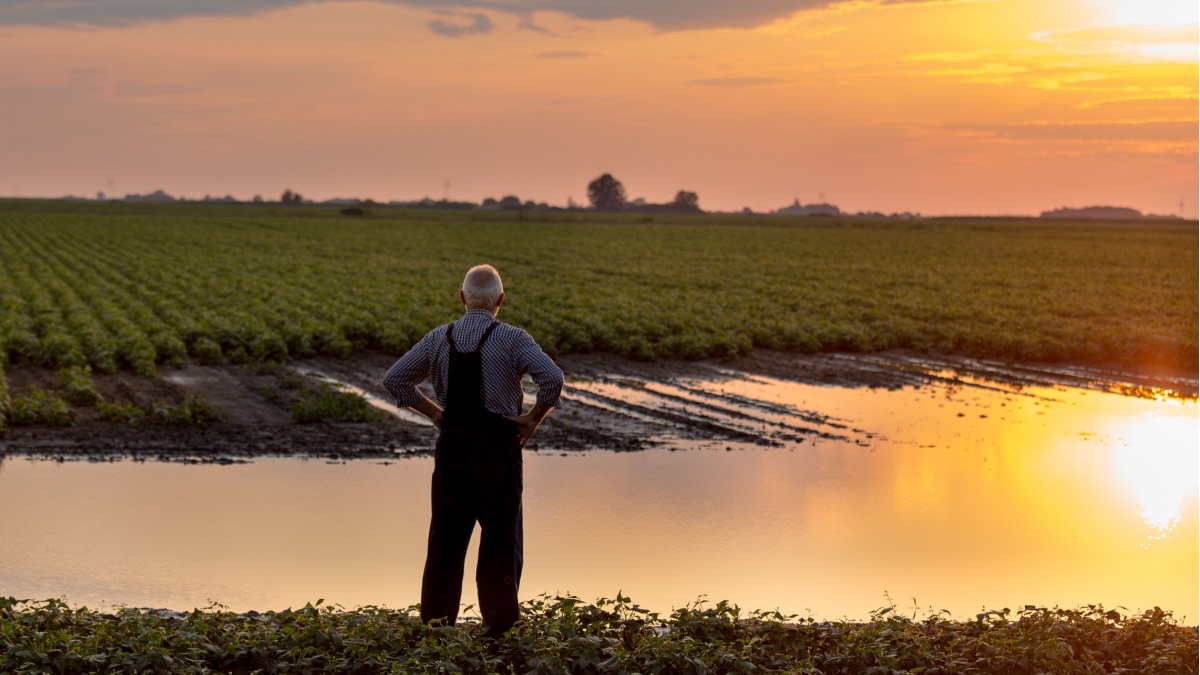Climate change and food safety

Do we need a greater focus on the food safety impacts of climate change? By David Burrows
Climate change constitutes a relevant driver of emerging risks, wrote experts from the Climate Change and Emerging risks for Food Safety (CLEFSA), in a 2020 report. But while a broad range of forward-looking studies and reports examine the impact of climate change on food security, the experts agreed that future challenges for food and feed safety, plant and animal health and nutritional quality are “usually not investigated in depth”.
“Climate change has the potential of causing, enhancing or modifying the occurrence and intensity of some food-borne diseases and the establishment of invasive alien species harmful to plant and animal health.”
Their 146-page report sought to address this. And by the time you have finished the abstract you are already worried about what picture the detail will paint.
“Climate change has the potential of causing, enhancing or modifying the occurrence and intensity of some food-borne diseases and the establishment of invasive alien species harmful to plant and animal health,” wrote Angelo Maggiore, Ana Afonso, Federico Barrucci and Giacomo De Sanctis. “It has an impact on the occurrence, intensity and toxicity of blooms of potentially toxic marine and freshwater algae and bacteria, on the dominance and persistence of various parasites, fungi, viruses, vectors and invasive species, harmful to plant and animal health.”
They also warned that climate change is “likely to drive the (re)emergence of new hazards, increase the exposure or the susceptibility to known hazards and change the levels of micronutrients and macronutrients in food and feed items”. And, for the kicker there was this: “By the very nature of the challenge, this list is inevitably incomplete, and undoubtedly unanticipated surprises await us in the future.”
Crunch ‘food’ COP
I came upon the CLEFSA report while researching various articles I was writing before, during and after the COP28 climate talks that took place in the United Arab Emirates at the end of 2023. “This year, diplomats are expected to argue over whether to phase out fossil fuels and who should help poorer nations pay for climate damages,” reported the Financial Times in the run-up.
The headlines did indeed focus on just a few words relating to fossil fuels, which the world will “transition away from” rather than “phase out”. Not ambitious enough, but still a ‘first’ for a COP summit as far as finger-pointing at fossil fuels goes. Other firsts included declarations on agriculture, food and health. Indeed, food finally had a place at the top COP table, with days dedicated to food, agriculture and water, as well as health.
Food systems also made it into the final text of the Global Stocktake (GST) – which looks at everything related to where the world stands on climate action and support, identifying the gaps and where collaboration can accelerate change. The GST recognises resilient food systems as essential for climate adaptation and notes the importance of “nature- based solutions” and “land use management”. As Lucy Wallace, chief of staff, EIT Food, noted: “I don’t think we should underestimate the power the food systems community has had by coming together [at COP28] – to influence the negotiations and to accelerate non-state actor action.”
But there is a long way to go. The UN Food and Agriculture Organization (FAO) is for example spending three years over the course of COPs 28, 29 and 30 to establish country action plans, monitoring and accountability to ensure food systems change sufficiently (and dramatically) to ensure that 1.5C limit is not breached (food is responsible for around a third of all greenhouse gas emissions). The first stage of this agrifood ‘roadmap’, published in December, noted that: “Accelerated climate actions can transform agrifood systems and help achieve food security and nutrition both today and tomorrow.”

Securing the supermarket shelf
Since then food security has been front-page news – which is news in itself. “Ireland, often touted as the food isle, is a major exporter of food and food produced here can feed up to 40 million people — we are the third largest exporter of butter globally and the fifth largest exporter of beef, staggering statistics for a small country,” noted the Irish Examiner in a special report on the topic published in April. “This might lead us to believe that as a nation we are self-sufficient and need not worry about food security, however, we are net importers of many of our most consumed foods.”
More than 20% of chicken – the most consumed meat in Ireland – is imported; so too 80%-plus of fruit and vegetables. Many prepared consumer foods also come from abroad. This reliance on the global market allows us to eat what we want when we want. But climate change is shaking that system – a system that many have warned has long been broken.
"We are well used to coping with wet weather but the present situation is beyond anything that could have been planned for." David Brown, President, UFU
In April, the Ulster Farmers' Union (UFU) warned there is "no doubt" that wet weather was now threatening domestic food production. Potato farmers predicted potential shortages and price rises as the weather curtailed early planting. "We are well used to coping with wet weather but the present situation is beyond anything that could have been planned for," said UFU president David Brown at the time.
The UK winter was one of the wettest on record, with farmer confidence levels “collapsing” according to the NFU. Farmers and the food chain need to adapt to a changing climate, but current implementation of adaptation is “too slow and fragmented”, according to the Environmental Protection Agency (EPA), which in January published Ireland’s first Climate Change Assessment Report (ICCA). Climate change “is happening” the EPA warned and “immediate and sustained actions” are likely to lead to sustained benefits – including for food security.
So, climate change is making a challenging situation worse and undermining food security. But is food safety also at risk?
Food safety last
Food security is defined by the World Bank as “all people, at all times, having physical and economic access to sufficient safe and nutritious food to meet their dietary needs and food preferences for an active and healthy life”.
“Climate change affects the durability and incidence of micro-organisms, harmful algae, fungi, mo[u]lds, patterns of food-related illnesses, and risk of toxic contamination.” Tara Heidari
Food security and food safety are two concepts both related to food risks. But as noted earlier, the influence of climate change on food production has hogged the spotlight, with food safety rarely getting a look in.
Start to consider the impacts of climate change and food safety and the list grows – and grows. “Climate change affects the durability and incidence of micro-organisms, harmful algae, fungi, mo[u]lds, patterns of food-related illnesses, and risk of toxic contamination,” explained Tara Heidari and colleagues from Iran in a 2023 paper. “In addition, changes in animal and plant pests lead to an increase in chemical pollution caused by the use of pesticides and antibiotics,” they added.
Indeed, when you start to think about it is impossible to ignore food safety when talking about climate change. Consider the fact that droughts reduce agricultural productivity and access to clean water. Or that mycotoxins are often more common in hot and humid areas (EFSA has identified changing patterns in mycotoxin contamination in cereal crops such as wheat, maize and rice).
As the European Food Information Council (eufic) noted more recently, in 2023, many food-borne pathogens, such as Salmonella spp. and Campylobacter spp., also grow well in warm, moist conditions, which many parts of Europe will increasingly experience due to global warming. (Worth noting is research by Spanish academics last year that found “no clear trend” as yet in developed countries that have information systems that document the occurrence of these diseases over time “in part because of extensive food conservation efforts”). Warmer temperatures in summer and milder winters may increase the number of pests, such as insects and rodents, which can spread foodborne pathogens. Similarly, excess rainfall leading to flooding could lead to contamination of crops with foodborne pathogens. The proliferation of algal blooms is also often registered as a concern for the aquaculture and seafood chains.
Food for the future
But we also need to think about how food production adapts to a changing climate. Will farmers need more chemicals to produce enough food, and what impact will this have on the levels of these found in our food? The exposure to supply chain risks and food insecurity can also open up gaps for food fraudsters to fill. And the greater use of veterinary medicines (like antibiotics) in farm animals could also increase the number of antibiotic-resistant pathogens, eufic said. And we also need to consider how the food system – including us – adapts. Diets that are lower in livestock products like meat and dairy are seen as a key solution to reducing the greenhouse gas emissions from food systems, and in turn limiting temperature rises to below 1.5C. This could mean eating different protein sources, including plant-based alternatives, insects, jellyfish, cultured meat and algae, which present challenges regarding food safety.
“There can be no food security without food safety and climate change threatens both.”
Concerns are rising as temperatures do. That 146-page CLEFSA report, for example, provided the bigger picture rather than the detail. Work is ongoing to better understand all these risks. In the Government of Ireland’s Food Vision 2030 report, action 10 (Goal 1, ‘Climate neutrality and resilience’) calls for a risk analysis of climate impacts on food production and food safety, which should cover in particular: soil health, crop production – their nutritional value and toxicity, particularly mycotoxins, animal health and onwards to human health, and animal welfare, algal bloom and aquaculture, pathogens across the food chain and biodiversity.
Preparedness has long been keen to high levels of food safety. That’s trickier in a chaotic climate. As the FAO Foresight report – Thinking about the future of food safety – notes: “To bring the future of food to reality, a proactive approach rather than a reactive response to climate impacts will be needed.”
Big data and artificial intelligence as ever promise much. They hold “great potential” as tools to help us develop the real-time food safety risk early warning systems of the future, wrote researchers led by Wageningen University, Netherlands in a July 2023 paper. But they are no silver bullet.
As the climate changes our food systems will change and so too will the risks around food safety. Experts at the FAO perhaps put it most pithily when, during a presentation document in 2020, they wrote: “There can be no food security without food safety and climate change threatens both.” With food security headline news surely now is the time for the food safety story to be told too.


